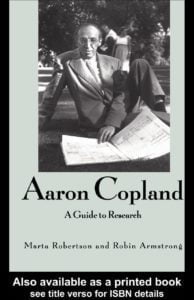Aaron Copland Four Piano Blues for Piano with sheet music
provider: dailymotion
url: https://dai.ly/k4Bl4nCkhkyipyxy7Av
src: https://geo.dailymotion.com/player.html?video=x875o8j&
src mod: https://geo.dailymotion.com/player.html?video=x875o8j
src gen: https://geo.dailymotion.com/player.html?video=k4Bl4nCkhkyipyxy7Av
Four Piano Blues (1926-48)
Though published in 1949, these brief pieces, exploiting various jazz-derived rhythmic features, date from different periods of Copland’s career. Each is dedicated to a well-known pianist.
“For Leo Smit” (1947). “Freely poetic.” A pastoral piece mixing beats of two and three eighth notes.
“For Andor Foldes” (1934). “Soft and languid.” When the falling thirds of the opening material return, they are combined with the “graceful, flowing” melody of the contrasting central section.
“For William Kapell” (1948). “Muted and sensuous.” The two contrasting ideas, louder and softer, of the beginning are gradually brought closer together.
“For John Kirkpatrick” (1926). “With bounce.” The earliest, and the most aggressively syncopated, of the set. Note the pauses that interrupt the rhythm in the second statement of the material.
(Andor Foldes is an eminent Hungarianborn pianist, who came to the United States in 1949. William Kapell, born in New York in 1923, was an extremely talented pianist who was tragically killed in an airplane crash at the age of thirty one.
John Kirkpatrick [b. 1905], who like Copland also studied with Nadia Boulanger in the mid-twenties, has long been active in the promotion of American music, especially that of Charles Ives.) The first performance of all four pieces was by Leo Smit at a League of Composers concert in New York on March
13, 1950.
Aaron Copland Danzón cubano with sheet music
provider: dailymotion
url: https://dai.ly/k3KYeUNiVeOBNwxy7Nn
src: https://geo.dailymotion.com/player.html?video=x875oup&
src mod: https://geo.dailymotion.com/player.html?video=x875oup
src gen: https://geo.dailymotion.com/player.html?video=k3KYeUNiVeOBNwxy7Nn

Danzón Cubano (1942)
In 1942, to celebrate the twentieth anniversary of the League of Composers, Copland wrote this impression of a Cuban dance style that he had observed during his tour the preceding year.
Danzón is not the familiar hectic, flashy, and rhythmically complicated type of Cuban dance. It is more elegant and curt, and is very precise as dance music goes. The dance hall itself seemed especially amusing to me because it had a touch of unconscious grotesquerie, as if it were an impression of “high-life” as seen through the eyes of the populace—elegance perceived by the inelegant…. I didn’t actually intend the piece to be grotesque, but, of course, there is that element in the original dance itself. Similar to that style, Danzón Cubano is very secco, very precise and elegant. It contrasts strong, rhythmically marked sections with a rather sentimental tune following immediately after, but not quite mixing with the dryness of the preceding part. (From liner notes to Columbia record M-33269.)
The first performance, by the composer and Leonard Bernstein, of the original two piano versions took place at New York’s Town Hall on December 17, 1942. Two years later, Copland made an orchestral version, which was introduced on February 17, 1946, by the Baltimore Symphony, Reginald Stewart conducting. Both Copland and Bernstein have conducted recordings of the orchestral version.
Aaron Copland The Cat and the Mouse (with sheet music)
Aaron Copland – Piano Fantasy with sheet music
provider: dailymotion
url: https://dai.ly/k5DTcAvNZ9iI6axLfiO
src: https://geo.dailymotion.com/player.html?video=x890pr6&
src mod: https://geo.dailymotion.com/player.html?video=x890pr6
src gen: https://geo.dailymotion.com/player.html?video=k5DTcAvNZ9iI6axLfiO
Aaron Copland – El Salón México Piano solo with sheet music (partitura)
provider: dailymotion
url: https://dai.ly/k3ZSLMxeLiGJjmxDNdm
src: https://geo.dailymotion.com/player.html?video=x87yn6g&
src mod: https://geo.dailymotion.com/player.html?video=x87yn6g
src gen: https://geo.dailymotion.com/player.html?video=k3ZSLMxeLiGJjmxDNdm
